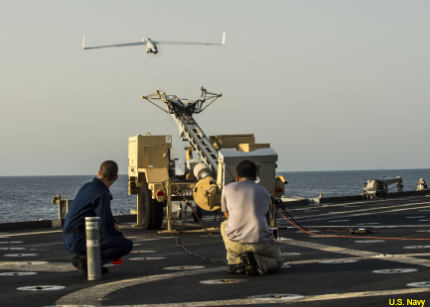Navy wants small drones that can see in the dark
The service is looking for small tactical unmanned aerial vehicles capable of providing ISR in both day and night operations in adverse environmental conditions.

The Navy is looking for a drone similar to the ScanEagle that can operate day or night.
While the Predator and Reaper drones operated by the Air Force steal most of the headlines, there are a significant number of smaller unmanned aircraft that provide important intelligence, surveillance and reconnaissance data within various environments around the world. The Navy, which already operates the catapult-launched ScanEagle and Blackjack, is interesting in procuring more tactical small unmanned aerial systems to provide ISR in day and night operations, as well as in adverse environmental conditions.
The Navy’s solicitation calls for an aircraft with a lightweight design akin to the size and specifications of the ScanEagle, which includes payloads capable of providing real-time full motion video through electro-optical and infrared sensors for maritime and land based operations.
The systems should be able to reach normal operating altitudes of 3,000-5,000 feet and avoid detection or enemy intervention for transit to and from the operating area, according to the solicitation. The aircraft should also be capable of autonomous or manual launch and recovery with quick deployment, defined as within 24 hours; long range missions, defined as a minimum of 10- to 12-hour flight times; and quick turnaround times between day and night operations.
The Navy also said that the systems being procured would help build foreign partner capacity.
Among a laundry list of specifications, the Navy said it is interested in systems that have been tested in a relevant operational environment, the performance attributes of sensors for both day and night are, the maximum ground speed detected in knots, the different types of flight modes and the mission characteristics of the aircraft, such as fly waypoints, loiter, hover and stare. Other criteria the Navy is looking at include how the ground control station communicates with the air vehicle, the type of data link used—including waveform, operational frequency band, analog or digital, and encryption capabilities—the data link range at different operating altitudes, and how the aircraft downloads and stores data through the ground control station and for how long.
The day and night capability is coveted making aircraft that can sufficiently provide ISR in both extremely useful. In fact, the Army announced in August an upgrade to the Raven UAS – significantly smaller than the ScanEagle – that incorporates infrared capabilities with daylight capabilities so cameras don’t have to be switched out.
Responses for the Navy’s solicitation are due on Jan. 28.



